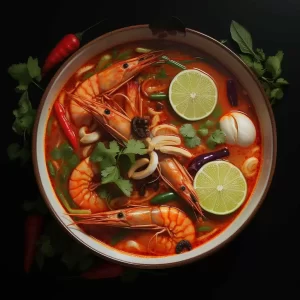
In the tapestry of culinary delights, few dishes are as versatile, comforting, and universally cherished as soup. From soothing classics like chicken noodle to exotic creations like Tom Yum, the world of soups offers an array of flavors and textures to tantalize our taste buds. In this exploration, we embark on a journey through the annals of soup history, savoring its rich tapestry, and discovering the secrets of crafting exceptional soups. Plus, we’ll unveil five exquisite soup recipes that showcase the artistry of this beloved dish.
Before we delve into the delightful depths of soup recipes, let’s skim the surface of its captivating history. Soups, you see, have been simmering in pots for centuries, dating back to the very dawn of human civilization.
The roots of soup can be traced to ancient civilizations, where resourceful cooks concocted simple broths by simmering meat and vegetables in water. The Egyptians were among the pioneers of soup-making, often blending ingredients like lentils and spices to create nourishing brews. Meanwhile, the Greeks and Romans elevated soup to an art form, producing concoctions that ranged from hearty to delicate.
In medieval Europe, soups emerged as a unifying force, transcending class boundaries. Peasants stewed humble ingredients in communal cauldrons, while the aristocracy savored lavish potages laden with exotic spices and ingredients. The concept of the communal soup pot was not just about sustenance; it represented a shared experience and a sense of belonging.
During the Renaissance, soup recipes proliferated as cookbooks made their debut. Elaborate concoctions featuring exotic ingredients from the New World graced the tables of the elite. As trade routes expanded, spices like pepper and cinnamon found their way into pots, enhancing flavors and solidifying soup’s position as a culinary staple.
As explorers charted new territories, they encountered diverse ingredients and culinary traditions. The exchange of goods and ideas led to a global fusion of flavors, giving birth to iconic soups like gumbo, miso, and minestrone. These soups, born of diverse cultures, reflect the rich tapestry of human history and migration.
Now that we’ve sipped from the wellspring of soup history, let’s uncover the secrets to creating sublime soups in your own kitchen.
At the heart of every soup lies a choice: to go with a clear, flavorful broth or opt for a velvety, creamy base. Broths, made by simmering meat, vegetables, and aromatics, offer a light and clean foundation. Cream-based soups, on the other hand, provide a luxurious, comforting texture. The choice depends on your palate and the desired outcome.
Layering flavors is the key to a memorable soup. Begin with a mirepoix (a combination of onions, carrots, and celery), add aromatic herbs and spices, and build upon these foundations. Remember, herbs like thyme and rosemary impart depth, while spices like cumin or paprika bring warmth and complexity.
Soup texture ranges from chunky to velvety-smooth. Consider the desired outcome and adjust accordingly. A hearty minestrone begs for chunky vegetables and beans, while a silky tomato bisque craves a thorough blend.
The magic of soup lies in the simmer. Low and slow allows flavors to meld and intensify. A hasty boil might lead to a rushed result. Patience pays off with soups; let them dance on the stove, allowing time for alchemy.
Don’t underestimate the power of a well-chosen garnish. A sprinkling of fresh herbs, a drizzle of high-quality olive oil, or a dollop of sour cream can elevate your soup from good to gourmet.
Soups, like languages, vary greatly across the globe, each with its own dialect of flavors. Let’s embark on a world tour of soup, sampling a taste of the diverse cultures and traditions that have contributed to this global culinary symphony.

Tom Yum, the fiery and aromatic Thai soup, exemplifies the balance of sweet, sour, salty, and spicy flavors. With ingredients like lemongrass, galangal, shrimp, and chili peppers, it’s a zesty and invigorating start to any meal.

When the Spanish sun blazes, Gazpacho comes to the rescue. This chilled tomato-based soup is a refreshing medley of ripe tomatoes, cucumbers, bell peppers, and onions, often garnished with croutons or a drizzle of olive oil.

Pho, Vietnam’s gift to the world, is a fragrant, complex broth made by simmering beef or chicken with herbs and spices. Served with rice noodles and a side of fresh herbs and lime, it’s a soothing and aromatic delight.

Borscht, the pride of Russia, is a hearty and vibrant beet soup. It combines earthy beets with cabbage, potatoes, and sometimes beef, resulting in a bowl of deep, ruby-colored warmth, often served with a dollop of sour cream.

Miso soup is a staple of Japanese cuisine, made from fermented soybean paste and seaweed. It’s light, savory, and comforting, often served with tofu and scallions. Miso soup is a gentle and nourishing start to a meal.
In the realm of culinary creations, soup stands as a masterpiece of adaptability, creativity, and nourishment. Its history spans epochs and continents, uniting cultures through shared traditions and ingredients. From Thai Tom Yum to Russian Borscht, soups offer a passport to the world’s flavors, providing sustenance and storytelling in every simmer.
So, the next time you stand before the stove, ladle in hand, remember that you’re partaking in a culinary tradition that transcends time and borders. Whether you’re crafting a cherished family recipe or embarking on a culinary adventure, soup remains a dish that warms not only the body but also the soul. With each spoonful, you’re savoring a taste of history, a tapestry of cultures, and a bowl full of heartwarming memories. Bon appétit!

Impress your friends with this amazing new innovation.
Hold your food and drink in one hand while you eat with the other

Immerse yourself in a fusion of flavors and entertainment as we intertwine the realms of food and living.